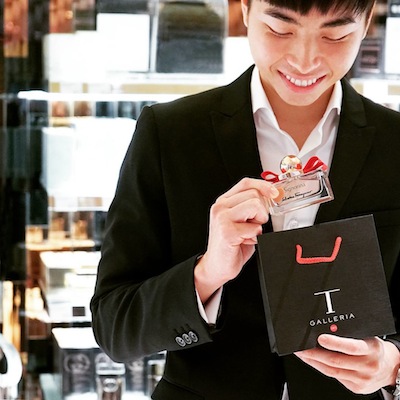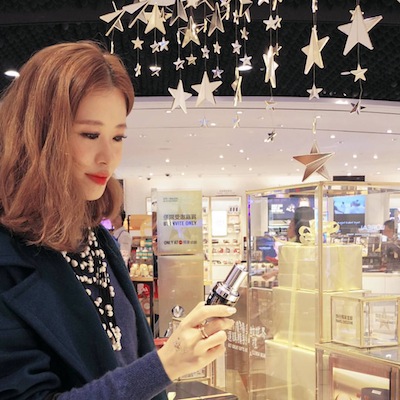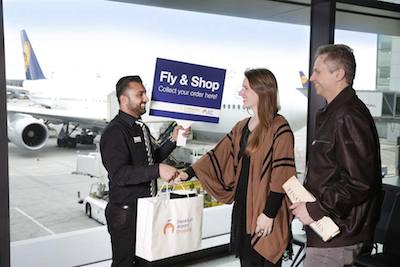 Shopper at DFS' T Galleria in Hong Kong
Shopper at DFS' T Galleria in Hong Kong
SEOUL, South Korea – Traveling Asian consumers and their penchant for duty-free shopping are shaping the future of luxury more so than any other trend, said a lead partner at McKinsey & Company during the Condé Nast International Luxury Conference April 20.
Led by the Chinese, Asia’s luxury consumer is a globetrotting, shopping abroad force that differs completely from affluent demographics based elsewhere. Contributing to 30 percent of duty-free transactions with an average spend that dwarfs other nations, Chinese consumers’ pull toward tax free shopping has cause the retail format to become a fruitful sub-market.
“It is not surprising that luxury airport duty-free is emerging as one of the most important sub-markets for the luxury industry,” said Aimee Kim, lead partner, retail at McKinsey & Company.
“In fact, many people are dubbing duty-free as the sixth continent for luxury retail,” she said.
Shop on-the-go
Per a McKinsey & Company survey, the luxury duty-free market has seen a 30 percent annual growth rate in the last two years, surpassing growth in the online sector.
As such, 60 percent of luxury spend in international capitals, such as Paris and London, is from tourists. On scale, two-thirds of Chinese luxury shopping happens outside the Mainland, and the growth of outbound affluent tourists is increasing at a higher frequency than non-luxury peers.
When traveling abroad, 60 percent of Chinese consumers look to buy products from the personal care category, followed by handbags and clothing. South Korean beauty brands especially have benefited from the surge of duty-free shopping undertaken by the Chinese.
 Duty-free shopper at DFS' T Galleria
The slowing of China’s economy has afforded neighboring countries such as South Korea an opportunity to become a tourist destination, which in effect has brought increased exposure to the country’s products.
South Korean beauty products have seen a rise in popularity at the expense of Western brands who entered the Chinese market when the playing field was more fruitful. According to L2’s “The Beauty China: The Rise of Korean Brands” Insight Report, Western skincare and color cosmetics have seen share erosion while interest in South Korean beauty is skyrocketing, now accounting for nearly a quarter of cosmetic imports to China (see story).
Driven abroad by the lure of cheaper prices, the latest products and a wider selection, the affluent Chinese gravitate toward Macau and Hong Kong for the first “taste” of luxury travel. After, South Korea offers broad base appeal for these consumers, as does Japan and the European Union.
Duty-free shopper at DFS' T Galleria
The slowing of China’s economy has afforded neighboring countries such as South Korea an opportunity to become a tourist destination, which in effect has brought increased exposure to the country’s products.
South Korean beauty products have seen a rise in popularity at the expense of Western brands who entered the Chinese market when the playing field was more fruitful. According to L2’s “The Beauty China: The Rise of Korean Brands” Insight Report, Western skincare and color cosmetics have seen share erosion while interest in South Korean beauty is skyrocketing, now accounting for nearly a quarter of cosmetic imports to China (see story).
Driven abroad by the lure of cheaper prices, the latest products and a wider selection, the affluent Chinese gravitate toward Macau and Hong Kong for the first “taste” of luxury travel. After, South Korea offers broad base appeal for these consumers, as does Japan and the European Union.
 Duty-free shopper at DFS' T Galleria
South Korea has benefited from its proximity to China and its consumers’ interest in duty-free, becoming the largest tax-free shopping market. Expected to continue its growth trajectory, South Korea saw $8 billion in duty-free shopping revenues for 2015.
Considered a “bell weather market,” South Korea is monitored by Chinese and South East Asian consumers for the latest trends in luxury. An interest in South Korean culture, including K-pop music and television dramas, has generated awareness for the market, leading to aspirational visits to purchase products used by South Korean celebrities.
Over the years, the duty-free market grew as a response with Incheon International Airport being considered the world’s largest. And unlike other markets, South Korea offers tourists a network of downtown tax-free shopping centers.
But, as affluent interest sways increasingly toward experiential travel to destinations such as Antarctica and Africa, rather than travel solely for consumption, duty-free shopping may face challenges in the coming years.
Indeed, if Chinese consumers do get caught up in experiential travel, there is still opportunity for duty-free shopping within the airport, especially if the visited destination does not offer a network of luxury bricks-and-mortar boutiques.
Luxury fly-bys
Given the duty-free success of South Korea’s Incheon International Airport, more airports are looking to tax-free shopping as a sustainable and attractive way to support commercial operations.
For instance, Germany’s Frankfurt Airport is enabling travelers to shop in a multichannel fashion with the launch of a new seamless ecommerce experience.
Powered by Magento Commerce, the platform will translate typical omnichannel shopping services, such as click and collect and home delivery to the airport retail environment. With retailers throughout its terminals carrying brands including Veuve Clicquot, Caviar House & Prunier and Gucci, this will simplify travel purchases (see story).
Duty-free shopper at DFS' T Galleria
South Korea has benefited from its proximity to China and its consumers’ interest in duty-free, becoming the largest tax-free shopping market. Expected to continue its growth trajectory, South Korea saw $8 billion in duty-free shopping revenues for 2015.
Considered a “bell weather market,” South Korea is monitored by Chinese and South East Asian consumers for the latest trends in luxury. An interest in South Korean culture, including K-pop music and television dramas, has generated awareness for the market, leading to aspirational visits to purchase products used by South Korean celebrities.
Over the years, the duty-free market grew as a response with Incheon International Airport being considered the world’s largest. And unlike other markets, South Korea offers tourists a network of downtown tax-free shopping centers.
But, as affluent interest sways increasingly toward experiential travel to destinations such as Antarctica and Africa, rather than travel solely for consumption, duty-free shopping may face challenges in the coming years.
Indeed, if Chinese consumers do get caught up in experiential travel, there is still opportunity for duty-free shopping within the airport, especially if the visited destination does not offer a network of luxury bricks-and-mortar boutiques.
Luxury fly-bys
Given the duty-free success of South Korea’s Incheon International Airport, more airports are looking to tax-free shopping as a sustainable and attractive way to support commercial operations.
For instance, Germany’s Frankfurt Airport is enabling travelers to shop in a multichannel fashion with the launch of a new seamless ecommerce experience.
Powered by Magento Commerce, the platform will translate typical omnichannel shopping services, such as click and collect and home delivery to the airport retail environment. With retailers throughout its terminals carrying brands including Veuve Clicquot, Caviar House & Prunier and Gucci, this will simplify travel purchases (see story).
 Frankfurt Airport's Fly & Shop
With competition for wallet share from the global luxury consumer being high, brands with a duty-free presence must consider a number of points going forward.
Overcapacity is vital, as duty-free is still retail, making the locale a primary driver. Brands should select well-positioned markets and keep in mind that tax-free shopping is part of travelers’ journeys and the time pressure of visiting for only a short time should be considered.
Likewise, regulations, such as custom inspections and visa policies, as well as foreign exchange rates, also come into play. Geopolitical tension, unless fundamental such as war or genocide, also impacts duty-free, but typically affects the industry on a short-term basis.
To end her discussion, Ms. Kim suggested that to win at duty-free, branding, pricing marketing, merchandising and experience tactics must be used. But, experiential efforts need to be fine-tuned to align luxury with duty-free outside the airport, as downtown duty-free centers often have an air of open-market chaos.
“We saw the bustling crowds in downtown duty-free retail; that’s quite exciting if you’re a duty-free retailer, but it does give us food for thought,” Ms. Kim said.
“How long will Asian consumers be willing to condone this type of non-luxury type of shopping experience where you’re literally rubbing shoulders with the shopper next to you?” she said.
“Finding ways to enhance the experience so that it is a bit more in line with the typical luxury experience will be an important thing that will differentiate luxury brands in the future.”
Frankfurt Airport's Fly & Shop
With competition for wallet share from the global luxury consumer being high, brands with a duty-free presence must consider a number of points going forward.
Overcapacity is vital, as duty-free is still retail, making the locale a primary driver. Brands should select well-positioned markets and keep in mind that tax-free shopping is part of travelers’ journeys and the time pressure of visiting for only a short time should be considered.
Likewise, regulations, such as custom inspections and visa policies, as well as foreign exchange rates, also come into play. Geopolitical tension, unless fundamental such as war or genocide, also impacts duty-free, but typically affects the industry on a short-term basis.
To end her discussion, Ms. Kim suggested that to win at duty-free, branding, pricing marketing, merchandising and experience tactics must be used. But, experiential efforts need to be fine-tuned to align luxury with duty-free outside the airport, as downtown duty-free centers often have an air of open-market chaos.
“We saw the bustling crowds in downtown duty-free retail; that’s quite exciting if you’re a duty-free retailer, but it does give us food for thought,” Ms. Kim said.
“How long will Asian consumers be willing to condone this type of non-luxury type of shopping experience where you’re literally rubbing shoulders with the shopper next to you?” she said.
“Finding ways to enhance the experience so that it is a bit more in line with the typical luxury experience will be an important thing that will differentiate luxury brands in the future.”
